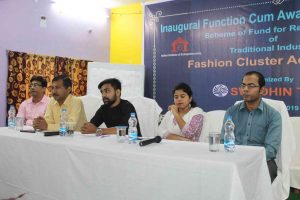1.1. India has a rich heritage of traditional industries. This sector not only plays a crucial role in providing large-scale employment opportunities at comparatively lower capital cost, but also helps in industrialization of rural & backward areas, thereby reducing regional imbalances, assuring more equitable distribution of income and wealth. The eco-friendly products of traditional industries have great potential for growth in production and export developing niche products for domestic and export markets.
1.2. Broadly, „traditional industry‟ means an activity which produces marketable products, using locally available raw material and skills and indigenous technology. Traditional Industry Cluster, in the context of this document, refers to a geographical concentration of a sizable number of artisans or micro enterprises, suppliers of raw materials, traders, service providers, etc. producing processing and servicing the same or similar types of products and facing common opportunities and threats.
1.3. The traditional industries are broadly categorized into Khadi (comprising of hand-spun and hand-woven cotton, woolen, muslin and silk varieties), Coir Based Industries and Village Industries (including non-timber forest produces-NTFPs, handmade paper, agro based goods, textiles based products and other miscellaneous microenterprises as detailed in Annexure 1).
1.4. With a view to making the traditional industries more productive and competitive and facilitating their sustainable development, the Govt. of India announced setting up of a fund for regeneration of traditional industries, with an initial allocation of Rs 100 crore. Pursuant to this announcement, a Central Sector Scheme titled the “Scheme of Fund for Regeneration of Traditional Industries (SFURTI)” was approved at a total cost of Rs 97.25 crore. The Scheme was implemented by the Ministry of Micro, Small and Medium Enterprises (MSME) and its organizations (Khadi and Village Industries Commission-KVIC and Coir Board), in collaboration with State Governments, their organizations and non-governmental organizations.
1.5. Separately, with a view to revitalizing the Khadi and Village Industries (KVI) sector, the Government of India, with the assistance of Asian Development Bank (ADB), had in 2009-10, introduced a comprehensive Khadi Reform and Development Programme (KRDP) which inter alia aimed at developing 5 thrust areas of traditional village industries such as herbal products, honey, handmade paper, leather and agro based industries through a cluster-based approach.
1.6. Planning Commission‟s Working Group on XII Plan has recommended continuation of SFURTI with its existing components like: replacement of equipment, setting up of common facilities, support for development of new products, designs, packaging, market promotion, capacity building activities, etc. It has also been recommended that a number of KVI schemes hitherto being implemented by KVIC in Khadi and Village Industries sectors with similar or overlapping objectives, be merged in SFURTI and give flexibility to Implementing Agencies to choose their own basket of components as per need. Thus the following schemes are being merged into SFURTI: The Scheme for Enhancing Productivity and Competitiveness of Khadi Industry and Artisans, the Scheme for Product Development, Design Intervention and Packaging (PRODIP), the Scheme for Rural Industries Service Center (RISC) and other small interventions like Ready Warp Units, Ready to Wear Mission, etc. run by KVIC during XI Plan from Khadi Grants and VI Grants.
1.7. Despite the success of the SFURTI scheme, an independent evaluation of the SFURTI clusters highlighted the need to improve the sustainability and competitiveness of these clusters. The recommendations include enhanced allocation per cluster, increased responsibility of the Technical Agencies (TAs), critical financial appraisal and development of robust business plans and convergence of programs at the cluster level.
1.8. As mentioned in the Budget announcement made by Finance Minister for 2013- 14, 800 clusters of khadi, village industries and coir are to be developed during XII Plan with an outlay of Rs 850 crore to cover 4 (four) lakh artisans. Assistance from Multilateral Development Banks is also to be leveraged, to extend support under SFURTI to 800 clusters during the XII Plan.
1.9. Clusters have gained increasing prominence in debates on economic development in recent years. Governments worldwide regard clusters as potential drivers of enterprise development and innovation. Cluster initiatives are also considered to be efficient policy instruments in that they allow for a concentration of resources and funding in targeted areas with a high growth and development potential that can spread beyond the target locations (spillover and multiplier effects).
1.10 Clusters are defined as “geographical concentrations of inter-connected enterprises and associated institutions that face common challenges and opportunities”. This definition highlights two essential features of clusters: they consist of a critical mass of enterprises located in geographical proximity to each other and enterprises within them share many common features.
